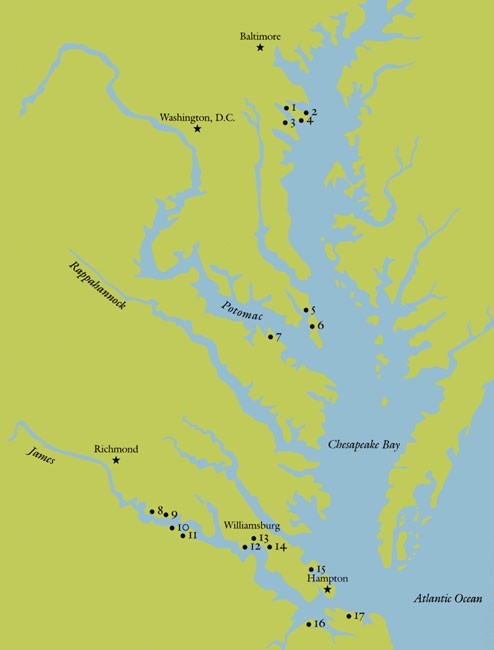
Map of the Chesapeake region showing the location of the principal archaeological sites discussed in the text. (Artwork, Nichole Drgan.)
1. Swan Cove
2. Homewood’s Lot
3. Burle’s Town Land
4. Broadneck
5. Old Chapel Field
6. St. Mary’s City (Pope’s Fort, St. Johns)
7. Nomini Plantation
8. Shirley Plantation
9. Walter Aston
10. Jordan’s Point
11. Flowerdew Hundred
12. Jamestown
13. College Landing
14. Kingsmill Tenement – Pettus
15. Bennett Farm
16. Harborview (Nansemond Fort)
17. Chesopean

Drawing of pipe mold, 1688. From Randle Holme’s Academy of Armory, shelfmark HARLEY.5955; FJ/245. (© British Library Board)
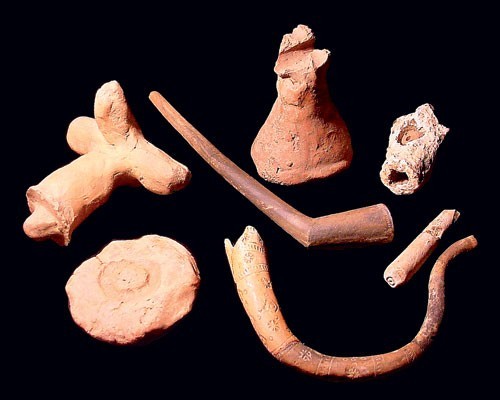
Kiln furniture and pipes, Emanuel Drue, Maryland, ca. 1660. Earthenware. (Courtesy, Anne Arundel County, Maryland; photo, Al Luckenbach.) Recovered from the Swan Cove site, these artifacts include cross-pipe props, decorating tool, bun, and pipes.

Tobacco pipes, Emanuel Drue, Maryland, ca. 1660. Earthenware. Top: Drue Type B, belly bowl. Center: Drue Type A, angular elbow. Bottom: presentation “Crumm Horn” pipe. (Courtesy, Anne Arundel County, Maryland; photo, Al Luckenbach.)

Tobacco pipe, Robert Cotton, Virginia, ca. 1608. Earthenware. (Preservation Virginia; photo, Beverly A. Straube.) This decorated elbow pipe is from the Jamestown excavations.
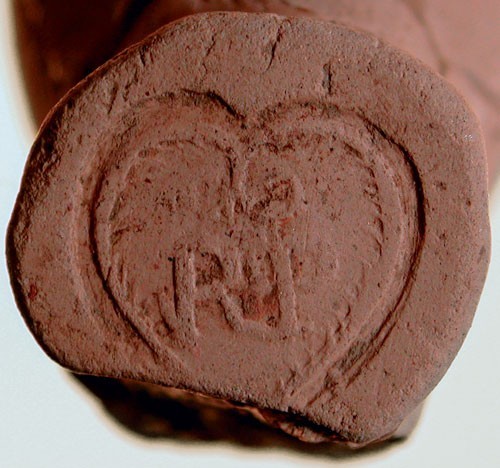
Tobacco pipe, Richard Pimmer, Virginia, ca. 1659. Earthenware. D. of spur .67"; H. of bowl 1.69". Mark: “RP” on pipe spur. (Courtesy, Virginia Department of Historic Resources; photo, Taft Kiser.) This pipe was found at the Nansemond Fort site (44SK192).
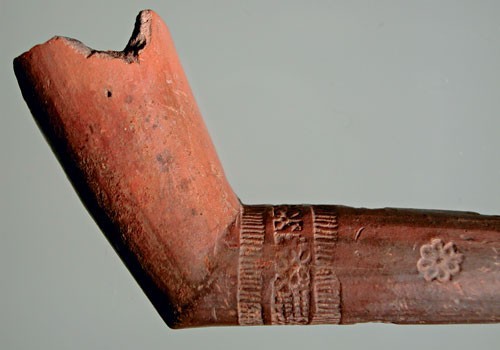
Tobacco pipe, Bookbinder, Virginia, ca. 1640. Earthenware. D. of stem .47"; D. of bore .15". (Courtesy, Virginia Department of Historic Resources; photo, Taft Kiser.) This angular elbow pipe is from the Chesopean site (44VB48).
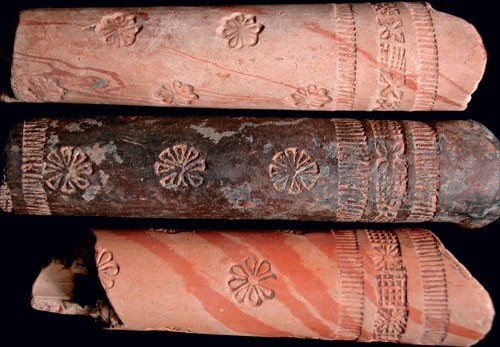
Tobacco pipe stems, Bookbinder, Virginia, ca. 1640. Earthenware. D. of pipe stem (average) .47"; D. of bore .14". (Courtesy, Virginia Department of Historic Resources; photo, Taft Kiser.) These three stems, found at the Chesopean site (44VB48), show the strict decorative grammar used by Bookbinder.

Tobacco pipe, Bookbinder, Virginia, ca. 1640. Earthenware. D. of stem .47"; D. of bore .14". (Courtesy, Virginia Department of Historic Resources; photo, Taft Kiser.) This close-up of a pipe from the Chesopean site (44VB48) shows Bookbinder’s detailed “grill work” decoration.
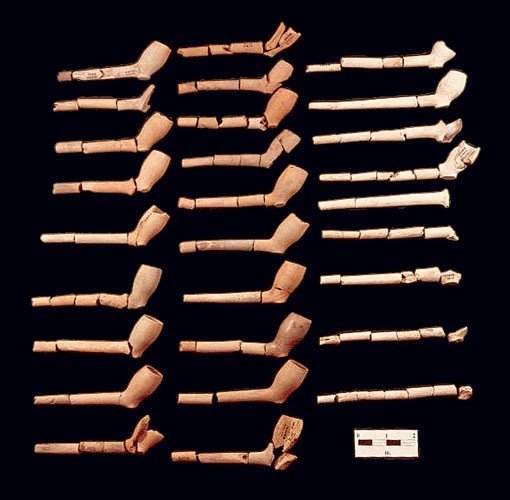
Tobacco pipes, Broadneck maker, Maryland, ca. 1650. Earthenware. (Courtesy, Anne Arundel County; photo, Al Luckenbach.) This complete assemblage of pipes from the Broadneck site (18AN818) shows the predominance of the Broadneck style.

Tobacco pipe, Broadneck maker, Virginia, ca. 1650. Earthenware. H. of bowl 1.61"; D. of bore .12". (Courtesy, Virginia Department of Historic Resources; photo, Taft Kiser.) This Broadneck bowl was found at the Wills Cove site (44SK56).

Tobacco pipe, Broadneck maker, Virginia, ca. 1650. Earthenware. D. of rim .75". (Courtesy, Virginia Department of Historic Resources; photo, Taft Kiser.) Broadneck rim decoration adorns this pipe from the Wills Cove site (44SK56).

Tobacco pipe, possibly J. Drue, ca. 1645. Earthenware. Mark: “JD.” (Courtesy, Preservation Virginia; photo, Beverly A. Straube.) This Broadneck-style pipe was recovered at the Jamestown excavations.
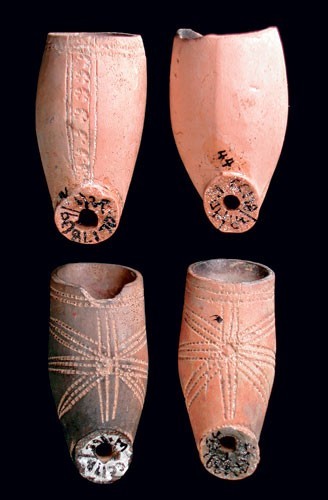
Tobacco pipes, Star Maker, Virginia, ca. 1640. Earthenware. H. of bowls (average) 1.65"; D. of bores .11–.12". (Courtesy, Virginia Department of Historic Resources; photo, Taft Kiser.) The Star Maker’s decorative grammar is represented on these four pipes from the Walter Aston site (44CC178).
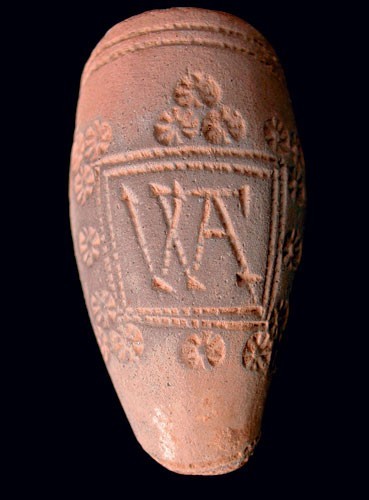
Tobacco pipe, Star Maker school, Virginia, ca. 1640. Earthenware. H. of bowl 1.5"; D. of bore .12". Mark: “WA” (Walter Aston?). (Courtesy, Virginia Department of Historic Resources; photo, Taft Kiser.) This Star Maker pipe was found at the Walter Aston site (44CC178).
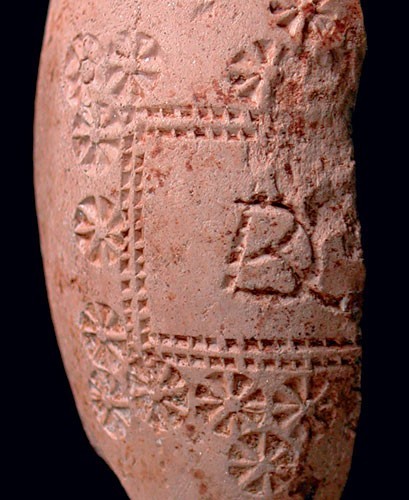
Tobacco pipe, Star Maker school, Virginia, ca. 1640. Earthenware. H. of bowl 1.26". Mark: “DK” (David Kirke?). (Courtesy, Virginia Department of Historic Resources; photo, Taft Kiser.) This example is from the Walter Aston site (44CC178).
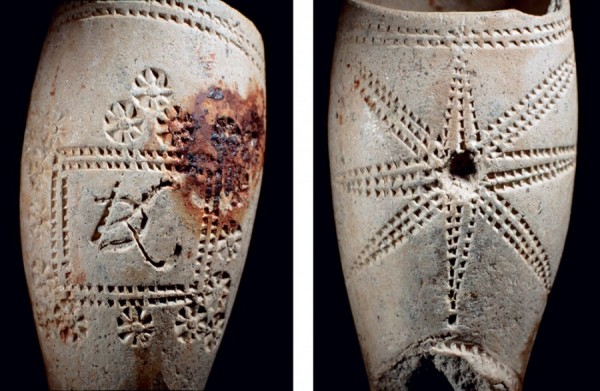
Tobacco pipe, Star Maker school, Virginia, ca. 1640. Earthenware. Mark: “DK” (David Kirke?). (Courtesy, Colony of Avalon Foundation; photo, Jim Tuck and Barry Gaulton.) This Star Maker pipe was found in Newfoundland. At left is the decorated mark that appears on one side of the bowl; at right is the bowl’s reverse side, showing a star decoration.
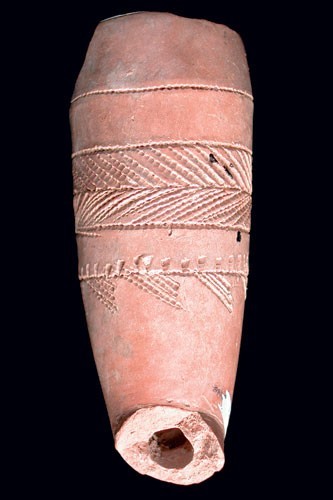
Tobacco pipe, Nomini Maker, Virginia, ca. 1660. Earthenware. H. of bowl 2.17"; D. of bore .17". (Courtesy, Virginia Department of Historic Resources; photo, Taft Kiser.) This version of a Nomini pipe was found at the Nomini Plantation (44WM12).

Tobacco pipe, Nomini Maker, Virginia, ca. 1660. Earthenware. H. of bowl 1.93"; D. of bore .15". (Courtesy, Virginia Department of Historic Resources; photo, Taft Kiser.)
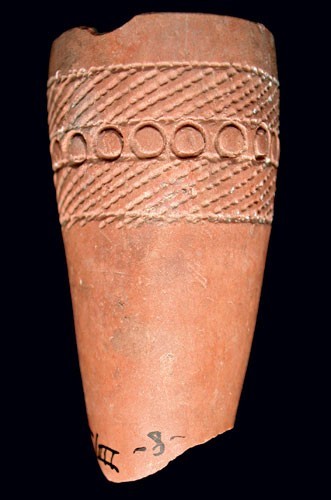
Tobacco pipe, Nomini Maker, Virginia, ca. 1660. Earthenware. H. of bowl 1.85". (Courtesy, Virginia Department of Historic Resources; photo, Taft Kiser.)
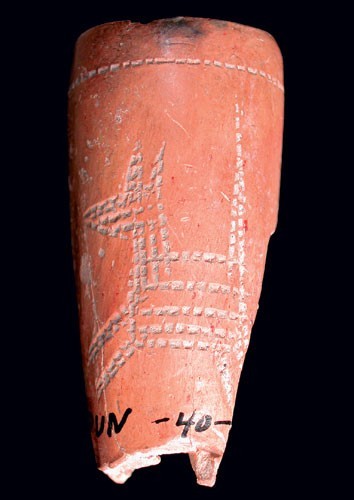
Tobacco pipe, Nomini Maker, Virginia, ca. 1660. Earthenware. H. of bowl 2.17". (Courtesy, Virginia Department of Historic Resources; photo, Taft Kiser.) Illustrated here is an example of a Running Deer pipe.
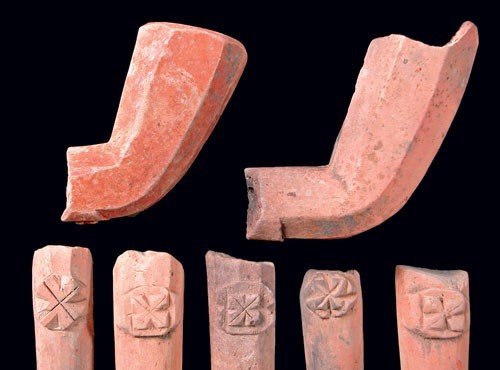
Tobacco pipes, The Carver, Virginia, ca. 1640. Earthenware. H. of bowl (average) 1.65"; D. of bore (average) .14". (Courtesy, Virginia Department of Historic Resources; photo, Taft Kiser.) This assemblage of bowls and stems is from the Kingsmill Tenement (44JC39).
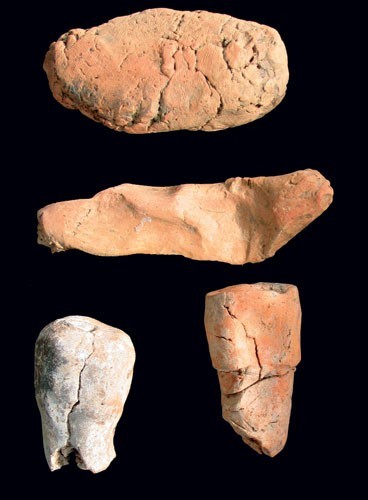
Pipe-making waste, Pope’s Fort Maker, Maryland, ca. 1646. Earthenware. (Courtesy, Historic St. Mary’s City, Maryland; photo, Silas Hurry.) This waste is from the moat at Pope’s Fort.

Tobacco pipe, Maryland, ca. 1660. Earthenware. (Courtesy, Anne Arundel County; photo, Shawn Sharpe.) Traditional Running Deer pipe from the Homewood’s Lot site, Anne Arundel County, Maryland.
In addition to their obvious functional utility, locally made seventeenth-century tobacco pipes have been recognized as the earliest surviving examples of folk art in the Chesapeake region.[1] The clay tobacco pipe, especially in its “terracotta” versions, is arguably the most studied colonial artifact type in the New World. Despite the fact that numerous authors have addressed the subject over the past several decades—particularly in regard to their social significance—the pipes have remained largely unclassified as to specific makers or geographic points of origin.[2]
This paper asserts that European colonists adopted an existing Native American tradition, and as the industry expanded it followed a model similar to that of early postmedieval country potters in England. Typical English country potters, like a local tobacco pipe maker, produced quantities intended for a limited regional market. Examples of long-distance distributions are rare, but significant when they occur.
These local manufacturers are often recognizable by surprisingly distinctive tobacco pipes, a fact no doubt related to the strong artistic component of their production. In this paper we will name and characterize the products of a number of idiosyncratic terracotta pipe manufacturers in the Chesapeake region and discuss their known distributions.
The discovery of the first known terracotta pipe kiln site at Swan Cove in Providence, Maryland, has provided a baseline against which to interpret existing pipe data from the region.[3] Many previous assumptions now seem questionable at best, and new avenues of interpretation are developing.
The Study of Chesapeake Terracotta Pipes
For several years, and with varying degrees of formality, the authors have surveyed archaeological collections of terracotta pipes from Maryland and Virginia (fig. 1). The idea of this study initially revolved somewhat around the concept that Emanuel Drue’s products (whose production site at Swan Cove had just been discovered) would be found in collections from distant sites. This proved not to be the case. In fact, it soon became apparent that terracotta pipe assemblages from different areas of the region actually had very little typological overlap.
With two notable exceptions, terracotta pipes did not travel far from their source of production. Relying on a limited catchment area for consumers, production amounts were necessarily small, although calculating estimates is not possible with currently available information.
While pipes are relatively easy to make, some researchers have overestimated their simplicity, postulating production in home fireplaces. An occasional “expedient pipe” might have been made in this fashion, but such limited production certainly would not have much impact on the archaeological record.[4] In reality, even a small-scale pipe maker like Emanuel Drue used a fairly complex arrangement of kiln, kiln furniture, clay processing, and decorating tools (fig. 2). We can assume that other makers discussed here worked on the same order of magnitude.
Terracotta pipes in the Chesapeake region were functional objects, made to smoke tobacco, but the plasticity of the medium and ease of decoration allowed for considerable decorative and stylistic variation. Apparent geographic isolation from other producers heightened this proclivity for stylistic diversity, resulting in variations in basic pipe shape and, most important, a palette on which producers could indulge in decorative embellishments. Daniel Mouer has termed the results “the most intriguing surviving examples of folk art of the early Chesapeake,” and further notes that the “care and effort which attended the creation of these artifacts attests to their symbolic importance.”[5] Such a perspective is fully supported here.
We contend that the regional variations of pipe makers (and perhaps their apprentices or later generations of related makers) are readily recognizable, and that a basic classification scheme will facilitate scholarly communication regarding these objects. While many previous works, including those in which we were involved, have used properly scientific classificatory terminology (such as “Type 5.08”), we feel that a return to the style of type nomenclature stressing geographic or stylistic characteristics would ultimately make for easier scientific discourse.[6]
Emanuel Drue
Situated on the banks of a relic cove off Mill Creek in Anne Arundel County, Maryland, the Swan Cove site (18AN934) was occupied by planter and tobacco pipe maker Emanuel Drue from the early 1650s until his death in 1669. Drue used state-of-the-art European production techniques in the manufacture of tobacco pipes made of native clays. The pipes and kiln debris recovered from Swan Cove (fig. 3) characterize the nature of a seventeenth-century industry that has long been sought in the Chesapeake.[7]
In addition to the unique assemblage of production-related artifacts, one of the most significant discoveries made at this site was that Drue produced two distinct pipe forms, a Native American–derived “Chesapeake” style angular elbow pipe and a European “belly bowl” (fig. 4), and each seems to have had its own decorative grammar. The elbow form (referred to as Drue Type A) was often decorated more exuberantly—with stamps and rouletted bowls and stems—in keeping with other products from the region. In stark contrast, with one exception the belly-bowl form (Drue Type B) was decorated in the same austere manner as similar European products—simply by rouletting the rim.
Another significant discovery was that Emanuel Drue produced a remarkable range of colored products—not because of the vagaries of manufacture, but because he selected clays specifically for their color variation. This fact was dramatically illustrated by hunks of raw clays discovered in intact trash pits that included gray, pink, and green varieties as well as a marbleized white/rose. These “gourmet” clays were used to produce both agatized pipes and pipes with slip-trailed surface decorations.
Perhaps equally noteworthy was the presence of large quantities of raw white clay, amply reflected in pure white examples of both types of Drue products. The presence of pure white Drue belly bowls with a standard simple roulette decoration at the rim has ominous implications for archaeologists trying to differentiate imported tobacco pipes from local ones.
The possibility that individuals might be producing unique expedient pipes has already been mentioned. Before such a statement can be supported, however, the possibility that they are “presentation pipes” needs to be considered. At least two examples have been recovered showing that Emanuel Drue produced elaborately decorated pipes of unique form (see fig. 3). Since one of these was recovered at the home site of his neighbor Robert Burle, it is assumed that it was specially made as a gift.[8]
The information gained from the excavation of Drue’s production site has greatly expanded our knowledge of how local tobacco pipe manufacturers operated as well as the range of their products, which, of course, has implications for interpreting the data available on other producers.
Robert Cotton
In 1608 a “Robert Cotton tobacco pipe maker” arrived in Jamestown.[9] Although Cotton then disappears from the documentary record, the Jamestown Rediscovery researchers have recovered a number of distinctive, local mold-made pipes with small bowls, chamfered stems, and European stamp decorations that appear to be his products (fig. 5). The stamps are apparently a match for some used in London between 1580 and 1610, and it is assumed that Cotton came from that city.[10] Obviously, he takes pride of place as the earliest European producer of pipes in the Chesapeake.
Cotton’s products, like those of most of the other makers discussed herein, apparently did not travel far from their source. In fact, to date none has been found outside the Jamestown settlement. Although fragments of what might be a muffle have been recovered, the exact location of Cotton’s kiln—and the wealth of data it might contain—await rediscovery.
Richard Pimmer
In 2001 two researchers working independently for the Lost Towns Project simultaneously produced information that allowed a third Chesapeake pipe maker (after Drue and Cotton) to be identified. In October of that year Taft Kiser, who was surveying and photographing Virginia collections of terracotta pipes, sent Al Luckenbach a picture of a pipe whose heel was marked with a clear RP (fig. 6). Examples of the pipe had been recovered from Calvert County, Maryland, among other locations, but given the large numbers originating from Nansemond Fort (44SK192) in southside Virginia, Kiser clearly was closer to the production source.[11]
At the same time, John Coombs was conducting documentary research for the project, scouring the records of the southside Virginia area for evidence relating to Emanuel Drue. Although unsuccessful in his primary goal, Coombs did discover important documents relating to two pipe makers, John Prescott and Richard Pimmer. Pimmer is recorded as having obtained materials to make “forty gross of pipes” as well as securing an indentured servant, Silvanus Gilpin, who was a pipe maker. Both references date from 1659 and place Pimmer in the region of Nansemond Fort. There seems little reason to doubt that the RP pipes are Richard Pimmer products.
Bookbinder
Some of the most distinctive clay tobacco pipes in the Chesapeake region are characterized by the use of marbleized clays and the most elaborate and detailed decorative treatments of any known maker (fig. 7). These marbled and stamped pipes have attracted attention from archaeologists for decades, and when Taft Kiser began collecting the distribution data in 1985 he applied the name “Bookbinder,” because the stamps and marbleizing resembled decorative work on book covers. William H. Ruppert, a Williamsburg leather worker, suggests the tools used to decorate the pipes might originally have been used to apply gilt to leather purses.
These intricate stamps occur on a single-elbow bowl form in a highly systematized and rigid grammar, the consistency of which, although executed with different tools on slightly variant forms, suggests a generational “Bookbinder school” of pipe making (figs. 8, 9).
The Bookbinder manufactory appears to have been in the vicinity of the Chesopean site (44VB48) in Virginia Beach, Virginia. Unlike nearly every other producer discussed in this article, however, Bookbinder’s products have been recovered from strikingly disparate localities.
In Virginia the greatest numbers came from the Chesopean site, but examples have also been recovered from Shirley Plantation (44CC15), Pettus (44JC33), Kingsmill Tenement (44JC39), Wills Cove (44SK56), Nomini Plantation (44WM12), Nansemond Fort (44SK192), Walter Aston (44CC178), Bennett Farm (44YO68), site 44JC568, College Landing (44JC952), and Jamestown.[12] In Maryland, Bookbinder products have been found at St. Mary’s City (Pope’s Fort and St. Johns),[13] in Old Chapel Field,[14] and at two sites in the Providence settlement in Anne Arundel County (Burle’s Town Land and Homewood’s Lot).[15] Bookbinder pipes have even been recovered at Renews, Newfoundland, fourteen hundred miles from their source.[16] These data indicate that these products were distributed under a notably different system from that used by the other makers discussed here.
With one exception, Bookbinder and associated Bookbinder-school pipes are the only local ones known to be decorated with elaborately cut rectangular wheel stamps. The exception is discussed in the following section.
Broadneck
The “Broadneck,” another distinctive pipe form, is found in large numbers at the Broadneck site (18AN818) in Anne Arundel County, Maryland, constituting 70 percent of the assemblage (fig. 10). At Pope’s Fort in St. Mary’s City this type was referred to as “a mold made variety with a double chevron motif.”[17]
The Broadneck maker used a rectangular wheel stamp with chevrons as rim decoration on otherwise undecorated pipes. The pipes are a weak oval-heeled form with thick walls and a profile that is distinctive enough to be readily recognized (figs. 11, 12). Marbleized clays were never used.
Broadneck pipes have been recovered in large numbers from the Chesopean site and Martin’s Hundred in Virginia; Pope’s Fort in southern Maryland; and the Broadneck site, Burle’s Town Land, and Homewood’s Lot in Providence, Maryland.[18] This is a fairly large distribution for a Chesapeake maker, nearly as large as that of Bookbinder. Drawing on an analogy from Emanuel Drue, this wide distribution suggests that the Broadneck form might, in fact, be a Type B belly-bowl form produced by the Bookbinder school, which otherwise is known only for angular elbow styles.
Dramatic new evidence bearing on such speculations was discovered in 2004 during the Jamestown Rediscovery excavations. Beverly Straube, lab director for the project, noticed a unique example of a Broadneck pipe that has initials on the heel (fig. 13). The initials appear to be ID—with the I barred, presumably meaning JD—although a minority opinion believes the second letter could be a distorted P. If the initials are in fact JD, then perhaps a member of the Drue family made the pipe. Given the numerous characteristics shared by pipes made by Emanuel Drue and Bookbinder (marbleizing, slip trailed decoration, and white clays, among others) the possibility that Broadneck forms are Bookbinder Type B belly-bowl forms and produced by a Drue means that Bookbinder might have been a Drue; thus the shared traits would have a familial explanation.
The theory that the initials are JP leads to other interesting possibilities—most notably, that Broadneck pipes might be the products of John Prescott, the pipe maker mentioned previously.
Star Maker
“Star Maker” produced and decorated terracotta elbow pipes with slightly bulbous bowls. The distinctive stars and paneled areas, which often contain initials, were achieved using rouletting and stamps (sometimes with white infilling) (figs. 14-16). At least three different molds were used in the production of these pipes. There is also some indication that apprentices might have been involved.
Star Maker worked either at the Walter Aston site (44CC178) in Charles City County, Virginia, or within a relatively short distance of it. Current data suggests that these pipes were distributed within a limited geographic area, with one notable exception. A decorated bowl with the initials DK was found at the house site of Sir David Kirke, in Ferryland, Newfoundland (fig. 17). The similarity of its style and stamps suggests that it was made by the same individual who produced the Star Maker–style bowl initialed WA that was found at the Walter Aston site (see fig.15). Production at this location seems to have taken place between about 1635 and 1660; there is evidence to suggest that some of these molds moved to Flowerdew Hundred site 44PG77 after 1660.[19]
A total of five distinct decorative grammars can be classified:
Star front and back. An eight-ray star on the front and back adorns the bowl, with the vertical rays open rather than pointed—the primary signature of this individual. The center of each star is marked with a circular stamp. Two rows of rouletting around the rim complete the grammar.
Star back with front panel. This decorative grammar includes a star on the back and two identical rows of rouletting around the rim. The front of the bowl has a rectangular panel that can contain initials, symbols, or stamped rosettes. Outside each corner of the panel is a cluster of stamped rosettes. Recorded initials are: EK, TF, IT, EA[?] and EM, IG, R[?]B, FB, E-, H-, T-. Apprentice bowls have HE, AH, and WA (the latter presumably Walter Aston).
Star back with undecorated front. The bowl has a star on the back and two rows of rouletting around the rim. The front is undecorated.
Back with two parallel vertical lines and stamps. On the back of the bowl is a vertical band consisting of two or more lines of parallel rouletting, with overlying rosette stamps. Two additional rows of rouletting are around the rim. There is no other decoration. Based on the form of the bowl and the character of the decoration, pipes with these elements are believed to be Star Maker products.
Bowls with no decoration. The bowl is molded and fired without any surface decoration, but based on the bowl form and the character of the decoration it is believed to be a Star Maker product. At least nineteen of these bowls are found in the Flowerdew Hundred Plantation archaeological collections, and these molds may have moved to that plantation after Walter Aston’s death, in 1656.
Nomini Maker
The Nomini Maker produced tall, slender elbow pipes in the vicinity of the Nomini Plantation (44WM12) in Westmoreland County, Virginia. The decorative grammar primarily involved the use of rouletting with occasional punctate and stamps and the use of white infill in the decoration (figs. 18-20).
Based on the style and decoration of the bowls, the Nomini Maker is believed to have been a Native American Algonquin who adapted a new pipe style from the “Running Deer” grammar (fig. 21). This is supported by a 1659 deed reference from Nomini that refers to “near the side of an Indian field commonly known as the Pipemaker’s field. . . .”[20]
Banded bowls have a rouletted band around the center of the bowl—in some cases simply two parallel lines, in others the two parallel lines enclose a wider band of diagonal rouletting. The decoration tends to go up from the central band, leaving the lower half of the bowl relatively undecorated, and may consist of individual rouletted bands, double bands, or double bands enclosing diagonals. A circular stamp is sometimes used—in one case forming a band, in another hanging from a band—and marks the ends of a four-pointed cross or star. The rouletted bands can also enclose hanging triangles and, in at least two cases, what appears to be an H. One bowl is decorated with incised or impressed cordons running in bands down the bowl.
Freehand bowls have a single band of rouletting around the rim and rouletted symbols. The symbols are typically in a pair: one faces the smoker, the other is on the bowl’s front. One symbol resembles a flat-bottomed V or a pair of spiked horns. Other symbols probably represent plants. Running deer are also used.
This collection contains a large amount of waste material that has yielded clues to the maker’s techniques. Apparently the pipes were rolled by hand, then shaped without using molds.
The overwhelming dominance of Nomini Maker among the local pipes at Nomini Plantation indicates that an individual, or related individuals producing a single style, worked at the site for an extended period of time. When death or departure ended the work of the maker—which Mitchell places prior to the introduction of the Morgan Jones pottery, in about 1677—the site continued to be occupied, although the dearth of other local products indicates that the occupants returned to those made in Europe. This suggests that the end date for this particular local pipe tradition falls in the late 1670s. Although this corresponds with the terminal dates for other makers discussed here, Native American makers continued to make decorated pipes into the eighteenth century.[21]
The Carver
Pipes that have been finished with a knife have been recovered at a number of sites. Some of these pipes, which often have a faceted appearance, are probably attempts to decorate home-produced expedient bowls, but there were clearly individuals making this style for local trade. Carving was labor-intensive, and production numbers would have been low compared to individuals working with molds.
One of these makers, “The Carver,” was working in the Jamestown area from about 1630 to 1645.[22] The Carver produced a square bowl beveled into an octagon, stopping the rear flats at the rounded stem while carrying the front facets under the bowl to a raised heel (fig. 22). In the final decorative stage the heel was incised with an X and elaborated into a raised cruciform pattern with clipped ends. The Carver was exceptionally skilled, creating simple yet distinctive bowls with balanced symmetry and flowing lines.
The Pope’s Fort Maker
St. Mary’s City in southern Maryland has clear evidence of a resident pipe maker for at least a brief period in the 1640s. Although no kiln debris has been found, wasters of hand-formed pipes have been discovered among the artifacts deposited in the fort ditch constructed by forces loyal to Parliament in 1645–1646 (fig. 23).[23] This trash may have been deposited about 1647/8 by William Bennett’s forces, who regained control of St. Mary’s City for the Calvert family at that time.
The Pope’s Fort Maker represents a fascinating and important example of the blending of pipe making traditions. These curved pipes with collars clearly represent a “Susquehanna” pipe shape, common among Iroquoian groups of the Northeast. They are, however, decorated with punctuate Running Deer designs directly related to Native American Algonquin forms. This amalgam is without parallel, and especially intriguing given the strong likelihood that the maker—or, perhaps, maker and decorator—were Caucasian Puritans, as there is no evidence of Native Americans participating in this expedition.
Conclusions
Identifying nine distinct manufacturers is important and satisfying, but numerous products exist that clearly are not those of any of the makers discussed here. Most are either unique examples (which might, in fact, be expedient or presentation pipes) or are found in very small numbers in known archaeological collections.
One major type of terracotta pipe—the Running Deer (figs. 21, 24)—has not been discussed here except in passing. This variety is perhaps the most discussed in the archaeological literature, given the central role it played in theories relating to African iconography. The position aYrmed here, and supported by a majority of researchers, is that these are clearly derived from a Native American Algonquin tradition. It is believed that the production of this stylistic tradition encompassed many makers and thus constitutes a distinct product category from the more idiosyncratic types examined in this essay. However, both the Nomini Maker and the Pope’s Fort Maker clearly demonstrate a direct influence from the Running Deer style; the Nomini Maker is likely a creolized Native American.
The main points of this paper are clearly demonstrable. The first—that the potential for individualistic expression in the manufacture of clay tobacco pipes allowed for products with considerable variation in shape and decoration—is obvious. More novel is the contention that many of these variations are clearly attributable to individual makers (or their “schools”), at least three of whom can now be named. The remainder have been given nominals capable of facilitating the exchange of future scientific discourse.
One of the unexpected outgrowths of this study was the realization that most of the pipes created by these makers were distributed in a limited geographic area. For all the evidence of elaborate kiln techniques discovered at Emanuel Drue’s pottery, his products—with one exception—served only the immediate vicinity of the Providence settlement. It appears that this was also true of six of the nine makers we have described.
Three of the makers had a much larger reach. Broadneck and Pimmer pipes are found over a large area of the Chesapeake region. Bookbinder achieves this distribution and more, having been carried into Newfoundland. The instance of the pipe of the Star Maker school also reaching Newfoundland seems predicated more on the novelty of the initialed bowl than on regular distribution.
In addition to distributional trends, one of the more important discoveries was of Emanuel Drue’s large production of two distinct pipe types, a belly bowl and an angular elbow pipe. If other pipe makers were following a similar practice this would greatly compound attributional difficulties. The possibility that Bookbinder’s angular elbows were being produced alongside either Broadneck belly bowls or RP belly bowls would, for example, reduce the numbers of makers who were operating beyond a local catchment, since all three enjoyed wider regional distribution.
Another important physical aspect of Drue’s products is the presence of white belly bowls with a rouletted rim, which are virtually indistinguishable from English products. How widespread such a practice might have been is currently unknown. Bookbinder produced off-white products, but their shape and decoration would not be confused with imports. The possibility therefore exists that some of the local versus imported pipe attributions made in numerous archaeological studies over the years might have unsuspected errors.
It is clear that many more tobacco pipe makers existed in the seventeenth-century Chesapeake region than have been identified; nevertheless, the ability to name three specific makers and to recognize their products is an important new phase in the history of such studies. It is hoped that future research will add significantly to the archaeological database.
See L. Daniel Mouer, “Chesapeake Creoles: The Creation of Folk Culture in Colonial Virginia,” in The Archaeology of Seventeenth Century Virginia, edited by Theodore J. Reinhart and Dennis J. Pogue (Richmond: Archaeological Society of Virginia, 1993), pp. 105–66.
See, for example, Matthew C. Emerson, “Decorated Clay Pipes from the Chesapeake” (Ph.D. diss., University of California, Berkeley, 1988); idem, “Decorated Clay Pipes from the Chesapeake: An African Connection,” in Historical Archaeology of the Chesapeake, edited by Paul A. Shackel and Barbara J. Little (Washington, D.C.: Smithsonian Institution Press, 1994), pp. 45–46; Mouer, “Chesapeake Creoles”; Fraser Neiman and Julia King, “Who Smoked Chesapeake Pipes?” (paper presented at Society for Historical Archaeology Conference, Salt Lake City, 1999); see also L. Daniel Mouer, Mary Ellen N. Hodges, Stephen R. Potter, Susan L. Henry Renaud, Ivor Noël Hume, Dennis J. Pogue, Martha W. McCartney, and Thomas E. Davidson, “Colonoware Pottery, Chesapeake Pipes, and ‘Uncritical Assumptions,’” in “I, too, am America”: Archaeological Studies of African-American Life, edited by Theresa A. Singleton (Charlottesville: University of Virginia Press, 1999), pp. 82–115.
Al Luckenbach, “The Swan Cove Kiln: Chesapeake Tobacco Pipe Production, Circa 1650–1669,” in Ceramics in America, edited by Robert Hunter (Hanover, N.H.: University Press of New England for the Chipstone Foundation, 2004), pp. 1–14; Al Luckenbach and C. Jane Cox, “Tobacco-Pipe Manufacturing in Early Maryland: The Swan Cove Site (ca. 1660–1669),” in The Clay Tobacco-Pipe in Anne Arundel County, Maryland (1650–1730), edited by Al Luckenbach, C. Jane Cox, and John Kille (Annapolis: Anne Arundel County Trust for Preservation, 2002), pp. 46–63.
Emerson, “Decorated Clay Pipes,” p. 36.
Mouer, “Chesapeake Creoles,” p. 129.
See, e.g., David Gadsby and Shawn Sharpe, “The Lost Towns Project Tobacco Pipe Classification Scheme,” in The Clay Tobacco-Pipe in Anne Arundel County, Maryland (1650–1730), edited by Al Luckenbach, C. Jane Cox, and John Kille (Annapolis: Anne Arundel County Trust for Preservation, 2002), pp. 4–10.
For expanded descriptions, see Luckenbach and Cox, “Tobacco-Pipe Manufacturing in Early Maryland,” and Luckenbach, “Swan Cove Kiln.”
See Al Luckenbach, Providence 1649: The History and Archaeology of Anne Arundel County, Maryland’s First European Settlement (Annapolis: Maryland State Archives; Crownsville: Maryland Historical Trust, 1995).
William M. Kelso and Beverly A. Straube, Jamestown Rediscovery, 1994–2004 (Richmond: Association for the Preservation of Virginia Antiquities, 2004), pp. 163–66.
Beverly A. Straube, personal communication, 2005.
Julia A. King, personal communication, 2002.
Many of these citations are based on collection analyses by Taft Kiser. For Nomini, see also Vivienne Mitchell, “Decorated Brown Clay Pipebowls from Nominy Plantation: Progress Report,” Quarterly Bulletin of the Archeological Society of Virginia 31, no. 2 (December 1976): 83; idem, “The History of Nominy Plantation with Emphasis on the Clay Tobacco Pipes,” in Historic Clay Tobacco Pipe Studies, edited by Byron Sudbury, 3 vols. (1980–), vol. 2 (1983), pp. 1–38; for Jamestown, see John L. Cotter, Archaeological Excavations at Jamestown Virginia (Archeological Society of Virginia Special Publication 4, 1958).
Henry M. Miller, “Tobacco Pipes from Pope’s Fort, St. Mary’s City, Maryland: An English Civil War Site on the American Frontier,” in The Archaeology of the Clay Tobacco Pipe, vol. 12, Chesapeake Bay, edited by Peter Davey and Dennis Pogue, British Archaeological Reports British Series, 566 (Oxford: B.A.R., 1991), pp. 73–88; Silas D. Hurry and Robert W. Keeler, “A Descriptive Analysis of the White Clay Tobacco Pipes from the St. John’s Site in St. Mary’s City, Maryland,” in ibid., pp. 37–72.
Christopher I. Sperling and Laura J. Galke, Phase II Archaeological Investigations of 18ST233 and 18ST329 Aboard Webster Field Annex, Naval Air Station, Patuxent River, St. Mary’s County, Maryland, report prepared for the Department of Public Works, Naval Air Station, Patuxent River, St. Mary’s County, Maryland.
Luckenbach and Cox, “Tobacco-Pipe Manufacturing in Early Maryland,” pp. 46–63.
Stephen Mills, “Seventeenth-Century Life in Renews, Newfoundland: Archaeological Analysis of an English West Country Planter’s House” (master’s thesis, Memorial University of Newfoundland, 2000), p. 159, fig. 13a.
Silas D. Hurry and Henry M. Miller, “The Varieties and Origins of Chesapeake Red Clay Tobacco Pipes: A Perspective from the Potomac Shore” (paper presented at the Society for Historical Archaeology Conference, Kingston, Jamaica, 1992).
See Ivor Noël Hume and Audrey Noël Hume, The Archaeology of Martin’s Hundred (Philadelphia: University of Pennsylvania; Williamsburg, Va.: Colonial Williamsburg Foundation, 2001); Miller, “Tobacco Pipes from Pope’s Fort,” pp. 73–88. For Providence sites, see The Clay Tobacco-Pipe in Anne Arundel County, Maryland (1650–1730), edited by Al Luckenbach, C. Jane Cox, and John Kille (Annapolis, Md.: Anne Arundel County Trust for Preservation, Inc., 2002), pp. 46–63.
For additional information and images, see www.flowerdew.org/pipe.html.
Mitchell, “Decorated Brown Clay Pipebowls from Nominy Plantation,” p. 83; see also idem, “History of Nominy Plantation,” pp. 1–38.
Dane T. Magoon, “‘Chesapeake’ Pipes and Uncritical Assumptions: A View from Northeastern North Carolina,” North Carolina Archaeology 49 (1999): 107–27.
Alain Charles Outlaw, Governor’s Land: Archaeology of Early Seventeenth-Century Virginia Settlements (Charlottesville: University of Virginia Press, 1990), pp. 78–79, esp. fig. 49.
See Henry M. Miller, Discovering Maryland’s First City: A Summary Report on the 1981– 1984 Archaeological Excavations in St. Mary’s City, Maryland, St. Mary’s City Archaeology Series, no. 2 (St. Mary’s City, Md.: St. Mary’s City Commission, 1986), p. 47; Miller, “Tobacco Pipes from Pope’s Fort,” pp. 73–88; Hurry and Miller, “The Varieties and Origins of Chesapeake Red Clay Tobacco Pipes.”
